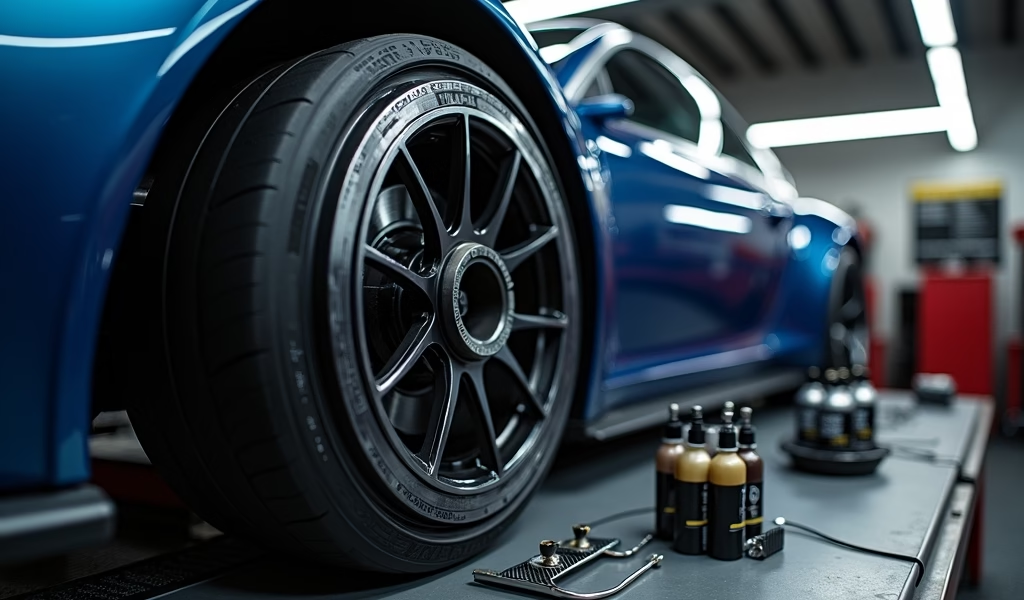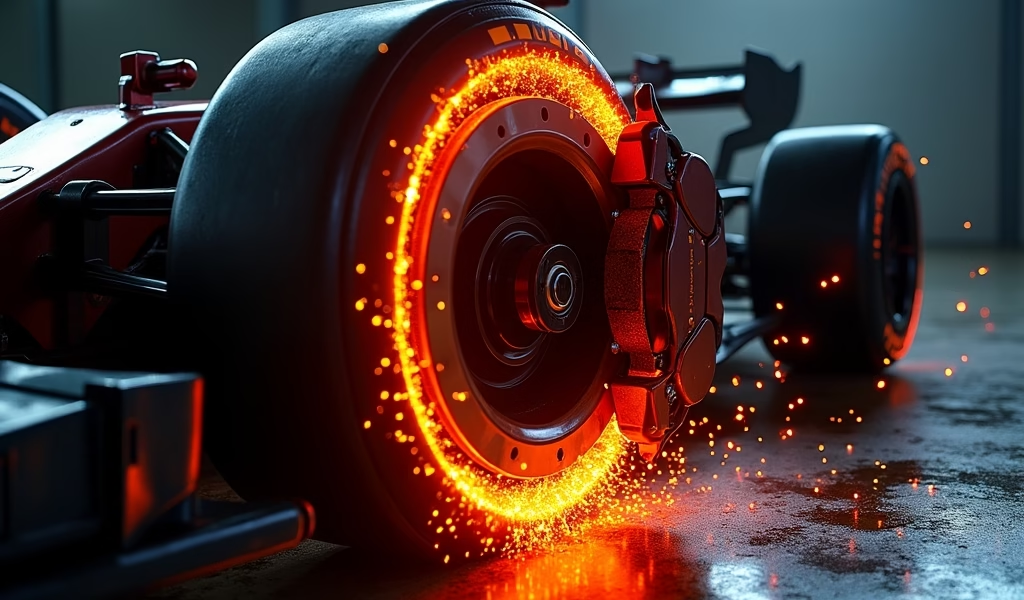Overview
The article provides seven essential tips for selecting racing brake pad compounds, emphasizing the importance of matching compounds to driving style, temperature ranges, and track conditions while properly understanding the balance between bite and modulation, wear rates, and bedding-in procedures. It highlights the differences between street and dedicated track compounds, noting that the ideal choice depends on specific needs rather than simply finding the “best” pads.
Table of Contents
- Understanding Racing Brake Pad Compounds
- Key Components of Racing Brake Pads
- Tip 1: Match Compounds to Your Driving Style
- Tip 2: Consider Temperature Ranges
- Tip 3: Balance Bite and Modulation
- Tip 4: Understand Wear Rates
- Tip 5: Bedding-In Procedures
- Tip 6: Track-Specific Considerations
- Tip 7: Street vs. Dedicated Track Compounds
- Conclusion
- Frequently Asked Questions
Understanding Racing Brake Pad Compounds
Choosing the right racing brake pad compound can make the difference between a podium finish and an also-ran performance. As someone who’s spent 20+ years getting my hands dirty with performance braking systems, I can tell you that the racing brake pad compound is far more than just a piece of friction material—it’s the critical interface between your foot and the track.
Racing brake pad compounds are specially formulated mixtures designed to perform under extreme conditions that would quickly destroy street pads. Unlike your everyday commuter pads, racing compounds are engineered to manage extraordinary heat levels while delivering consistent friction characteristics that allow drivers to brake later, harder, and with more control.
The science behind these compounds involves a delicate balance of materials including resins, fibers, lubricants, abrasives, and fillers. Each ingredient plays a specific role in creating the pad’s unique personality—from initial bite to fade resistance to wear characteristics. Getting this formula right is both art and science, which is why top motorsport teams spend countless hours testing different compounds for specific tracks and conditions.
Key Components of Racing Brake Pads
Before diving into specific tips, let’s break down what actually goes into a racing brake pad compound. Most high-performance brake pads consist of four main elements:
- Base materials (organic fibers, metallic particles, ceramic compounds)
- Binding resins to hold everything together
- Friction modifiers that fine-tune stopping power
- Backing plates that provide structure and heat dissipation
The specific blend of these materials creates distinct pad characteristics. For instance, metallic compounds generally offer excellent heat capacity but might be more aggressive on rotors, while ceramic-based compounds typically provide cleaner operation with less dust but might not have the same peak performance as some metallic formulations.
Understanding these components helps you appreciate why different racing brake pad compounds behave so differently on track. A pad that works brilliantly for endurance racing might be entirely unsuitable for sprint events, just as a compound that performs perfectly in dry conditions might become unpredictable in the wet.

Tip 1: Match Compounds to Your Driving Style
One of the most common mistakes I see at the track is drivers choosing a racing brake pad compound based solely on what the fastest guy is using. Here’s the truth: your driving style should dictate your pad selection just as much as your vehicle or track conditions.
If you’re a smooth operator who builds brake pressure progressively, you’ll likely prefer a compound with excellent modulation characteristics. These pads provide feedback that allows you to finesse the braking zone, making micro-adjustments as needed. Studies from Brembo show that progressive braking techniques can extend pad life by up to 15% while maintaining competitive lap times.
On the flip side, if you’re more of a “stab and grab” braker who hits the pedal hard and releases quickly, you’ll want a compound with aggressive initial bite that responds instantly to input. These compounds typically contain higher percentages of metallic content and ceramic materials that engage quickly under pressure.
To determine what works best for you, start with a middle-of-the-road compound and pay attention to how it feels. Are you constantly wishing for more immediate stopping power? Or do you find yourself struggling to modulate braking precisely? The answers to these questions will guide you toward your ideal racing brake pad compound.
Tip 2: Consider Temperature Ranges
Perhaps the most critical factor in racing brake pad compound selection is understanding temperature ranges. Every racing pad has an optimal operating temperature window where it performs at its best. Outside this range, performance can deteriorate dramatically—sometimes with dangerous consequences.
Low-temperature performance is especially important during the initial laps when your brakes haven’t fully warmed up. Some aggressive racing compounds are virtually ineffective when cold, providing minimal stopping power until they reach several hundred degrees. This characteristic can be downright dangerous if you’re unaware of it.
High-temperature performance, or fade resistance, becomes crucial during sustained hard braking or at tracks with limited cooling opportunities. When brake rotors can’t dissipate heat quickly enough, temperatures climb rapidly. Lower-grade compounds will begin to “gas out” as the binding resins break down, creating a slippery layer between pad and rotor that drastically reduces friction.
The most versatile racing brake pad compounds offer what we call a “wide temperature window,” performing reasonably well from cold to hot. However, these jack-of-all-trades compounds typically sacrifice some peak performance compared to more specialized options. For serious competitors, having different pad sets for different conditions might be worth considering.
Tip 3: Balance Bite and Modulation
The relationship between initial bite and progressive modulation is one of the most nuanced aspects of racing brake pad compound selection. Initial bite refers to how quickly and aggressively the pads engage when you first apply pressure to the brake pedal. Modulation describes how predictably the braking force increases as you apply more pedal pressure.
High-bite compounds give you that immediate, neck-snapping deceleration that can shave precious tenths in the braking zone. However, these compounds can sometimes be “digital” in their response—either on or off with little gray area in between. This makes threshold braking (maintaining the brake pressure right at the point before lockup) extremely challenging.
Compounds focused on modulation sacrifice some of that initial aggression for a more linear response curve. This allows drivers to make fine adjustments throughout the braking zone, potentially improving overall consistency and reducing the likelihood of flat-spotted tires from lockups.
The sweet spot varies by discipline. Autocrossers and sprint racers often prefer higher initial bite to maximize their limited braking zones, while endurance racers typically value modulation for its consistency over long stints. Your vehicle’s weight, downforce, and tire grip also factor into this equation—more mechanical grip generally calls for more progressive compounds to avoid overwhelming the tires.
Tip 4: Understand Wear Rates
While performance should be your primary consideration for racing applications, understanding wear characteristics of different racing brake pad compounds can save you significant money and maintenance time over a season. Generally speaking, harder compounds last longer but take more heat to reach optimal operating temperature, while softer compounds offer quicker warm-up but wear faster.
The trade-off isn’t always straightforward. Some advanced racing compounds use exotic materials that offer both exceptional performance and reasonable durability, though you’ll certainly pay a premium for these formulations. Understanding how brake pad wear sensors operate in racing applications can also help you monitor pad life more effectively.
One often overlooked factor is how different compounds affect your brake rotors. Some highly aggressive racing pad compounds will chew through rotors at an alarming rate, potentially making them more expensive in the long run despite the pads themselves lasting longer. Others are more rotor-friendly but might not deliver the same peak performance.
For amateur racers on a budget, consider having different compounds for practice sessions versus qualifying and race day. This strategy lets you save the expensive, high-performance (but perhaps shorter-lived) pads for when they really matter, while using more economical options for general practice and setup work.

Tip 5: Bedding-In Procedures
Proper bedding-in procedures are non-negotiable when it comes to racing brake pad compounds. This critical process creates an even transfer layer of pad material on the rotor surface, ensuring consistent performance and preventing uneven wear or thermal issues. Skipping or improperly executing this step can permanently compromise your braking system’s capabilities.
The specific bedding procedure varies by manufacturer and compound, but most follow a similar pattern: a series of moderate braking events from medium speed, followed by a cooling period without coming to a complete stop. This pattern gradually builds heat in the system while transferring pad material to the rotor surface in a controlled manner.
Here’s a generic bedding procedure that works for most racing compounds:
- Make 8-10 moderate brake applications from 60 mph down to 10 mph
- Follow with 2-3 harder braking events from 70 mph to 10 mph
- Allow 10-15 minutes of cool-down driving without using the brakes heavily
- Park the vehicle with the brakes fully released to prevent material transfer spots
Remember that different racing brake pad compounds have different bedding requirements. Some high-performance compounds require multiple heat cycles before reaching their full potential. According to StopTech, proper bedding can improve brake torque by up to 40% compared to unbedded pads of the same compound.
Tip 6: Track-Specific Considerations
Not all racing venues demand the same things from your braking system. The ideal racing brake pad compound for a fast, flowing track with few heavy braking zones (like Road Atlanta) differs significantly from what you’d want at a stop-and-go circuit with numerous hairpins (like Sonoma).
Tracks with long straights followed by tight corners put enormous thermal loads on braking systems. For these venues, prioritize compounds with excellent fade resistance and high-temperature stability. Some professional teams even use different compound mixtures for front and rear applications to balance the system based on weight transfer characteristics.
Technical tracks with multiple braking zones in quick succession might not generate the same peak temperatures but require compounds that can recover quickly between applications. In these scenarios, heat dissipation becomes as important as heat tolerance.
Environmental factors play a huge role too. A compound that works brilliantly in the dry Arizona heat might become unpredictable in humid Florida conditions. Similarly, cooler ambient temperatures might prevent some harder compounds from ever reaching their optimal operating window. Seasonal changes at your local track should inform your pad selection throughout the year.
Many experienced racers keep detailed notes about which compounds worked best at specific tracks under various conditions. This racing journal becomes invaluable over time, allowing you to make increasingly refined choices based on empirical data rather than guesswork.
Tip 7: Street vs. Dedicated Track Compounds
For weekend warriors driving their cars to and from the track, the dilemma of street-friendly versus dedicated racing brake pad compounds is very real. True racing compounds often perform poorly during street driving—they’re noisy, dusty, wear rotors aggressively, and might not provide adequate stopping power until they’ve heated up.
Hybrid or “street/track” compounds offer a compromise that works reasonably well in both environments. These formulations typically sacrifice some peak track performance for civilized street manners and cold-braking capability. For most amateur track day enthusiasts, these represent the sweet spot in the racing brake pad compound spectrum.
If you’re serious about extracting maximum performance, consider a pad change at the track. Modern caliper designs make this less daunting than it sounds—many experienced track day participants can swap pads in 30-45 minutes with basic tools. This approach gives you the best of both worlds: comfortable street driving and uncompromised track performance.
Whatever approach you choose, remember that mixing pad compounds (different formulations on different wheels) is generally not recommended. This creates unpredictable brake bias situations that can lead to dangerous handling characteristics, especially during hard braking maneuvers where weight transfer is already shifting the car’s balance.
Conclusion
Selecting the optimal racing brake pad compound isn’t just about finding the “best” pads—it’s about finding the right formulation for your specific needs, driving style, vehicle, and track conditions. The seven tips outlined above provide a framework for making informed decisions that will enhance both your performance and safety on track.
Remember that brake system performance represents one of the most significant advantages you can gain over competitors. While everyone focuses on horsepower and aerodynamics, the ability to brake later and harder with complete confidence often yields more substantial lap time improvements at a fraction of the cost.
As with most aspects of motorsport, experimentation and careful documentation are your allies in the quest for the perfect racing brake pad compound. Don’t be afraid to try different options, keeping detailed notes about their performance characteristics under various conditions. What works for one driver in one car might not work for you, so trust your sensations and data over marketing claims.
Whether you’re a casual track day enthusiast or a serious competitor, investing time in understanding racing brake pad compounds will pay dividends in performance, consistency, and ultimately, the sheer joy of driving at the limit with absolute confidence in your stopping power.
Frequently Asked Questions
What makes racing brake pads different from street pads?
Racing brake pads use compounds optimized for high-temperature operation and extreme friction characteristics. They sacrifice everyday comfort features (like noise suppression) to maximize stopping power and fade resistance under track conditions.
How often should I replace racing brake pads?
Replace racing pads when they’ve worn to approximately 3-4mm of friction material remaining or show signs of uneven wear. Always inspect pads after every track event rather than relying solely on mileage.
Can I mix different brake pad compounds front to rear?
While some professional teams use different compounds front to rear for specialized setups, it’s generally not recommended for amateur racers. Mixing compounds can create unpredictable brake bias and handling characteristics.
Will racing brake pad compounds damage my rotors?
Most racing compounds wear rotors faster than street pads due to their more aggressive friction materials. Higher-end rotors with specialized metallurgy are recommended for track use to withstand the increased thermal and abrasive demands.
Are more expensive racing brake pad compounds always better?
Not necessarily—the “best” compound depends on your specific application, driving style, and conditions. Sometimes a mid-range compound with characteristics that match your needs will outperform a more expensive option that’s poorly matched to your requirements.

